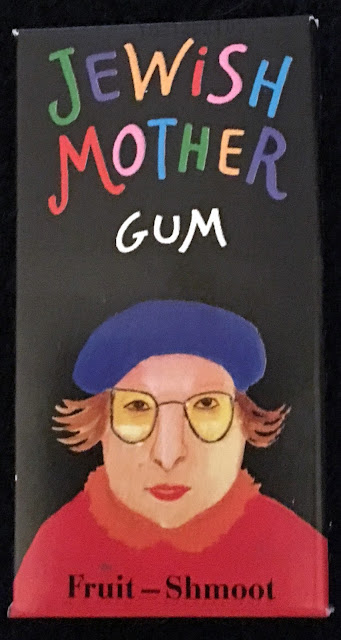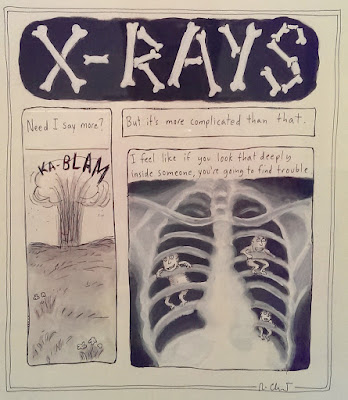Valerie says: Recently, while Jean was working much too hard and I was nursing a broken wrist (see Exhibit A, above, a cast swaddled in a cartoon stocking), I had the opportunity to attend the Metropolitan Museum of Art's current treasure of a costume show, Masterworks: Unpacking Fashion. By now the world is accustomed to one blockbuster after another at the Met's Costume Institute - starting several years ago with the Alexander McQueen retrospective, followed by the Punk show, the China show, and this year by the Manus ex Machina exhibition. Masterworks, by contrast, is a wonderful small show. Even at a leisurely pace, the whole thing can probably be savored in an hour or less. But going to see Masterworks is like taking an amphetamine - it's a powerful punch packed into a tiny package and sends the mind racing in new directions.
Andrew Bolton, Head Curator of the Costume Institute (above, in fashionably tight short trousers and skinny tie, and repeated in someone's cell phone), explained that the Institute had revised its collection strategy, and instead of aiming for an "encyclopedic" collection covering everything, the Museum would instead purchase "iconic" pieces embodying "costume as a living art". The current show was conceived as an opportunity to showcase acquisitions of the past 10 years. It covers over 200 years of the best of fashion, although most of the works on display are from the 20th century and represent a Who's Who of the best known, most respected, most innovative designers, from Worth at the close of the 19th century to Iris van Herpen at the beginning of the 21st. A number of these were donated by the designers in honor of Harold Koda, who retired as Curator in Charge of The Costume Institute in January of this year.
It would be nice if I could show you everything, but I'm just going to show you my favorites and leave you begging for more*.
In the opening photo, I'm standing in front of two bustiers, the one on the left by Yohji Yamamoto; the one on the right by Issey Miyake. They look small because I'm several feet away from them, but they are big, bold, and irresistible. Many of you have seen the molded resin Miyake bustier on Grace Jones. The Yohji bustier has rows of external ribs that rise provocatively at the breast, and hug the body sensuously at the torso. A few of those ribs are clearly visible in the photo.
The show itself opens with this dress by Viktor & Rolf.
It's the perfect dress to set the tone for the rest of the show, calling into question what you see, what you think you see, and the very nature of the dressmaker's art. While based on a traditional dress from a conservative period, the missing center section not only makes the dress new, it adds a sense of humor, and begs the question how did they do that?!
This 1947 evening dress, designed by Adrian, dressmaker to the Hollywood stars, features a surrealist motif designed by Salvador Dali.
I fell in love with this huge-shouldered jacket by Alexander McQueen. The accompanying label notes that the birds were hand-painted onto the fabric. The white dots you see are reflections of the lights in the glass.
In this dress, Sarah Burton, who succeeded Alexander McQueen following his untimely death, continues his obsession for extravagance using what appear to be countless butterfly wings as the dress's primary fabric.
In fact, however, the label reads that the "hundreds of trompe l'oeil wings that veneer the textile ground are composed of meticulously cut, dyed and painted feathers, applied by hand..." Below, a detail shot.
You could be forgiven for thinking the black and white sheath below was a Charles James dress. It has the same body-hugging hourglass figure of a Charles James, and the same wonderful pooling of fabric at the feet. But no, this is Azzedine Alaia who, it turns out, was a James admirer. A careful look at the dress reveals that the dress is composed of rows of sumptuous chenille interspersed with flat knit.
For most of us, most of the time, there is an unwritten understanding that fashion must be practical. It mustn't weigh more than the wearer can support; it mustn't be too large to enter a doorway; it must be cleanable; it mustn't impede movement... And yet someone is always breaking one of those rules. Here is Yamamoto's wood laminate dress with hinges. The skeptic in me asks how would you sit in this dress? how could you seduce, or be seduced, in this dress? But the gadfly in me loves the cubist look of the wood panels and the use of hinges to replace folds. One could almost imagine it among the costumes of Russian revolutionary theater, worn by someone too busy to be seated or comfortable.
Another Japanese designer who constantly tests the limits of definitions of dress is Rei Kawakubo. Because this marvelous abstract creation in wool-nylon flannel, patent leather, polyester georgette and cotton lawn is difficult to comprehend on the headless mannequin, scroll down to see how it looked on the model who wore it on the catwalk.
 |
| photo Vogue.com |
John Galliano for Maison Margiela did a marvelous coatdress which combined the old fashioned concepts of drama and romance with very new material. The coat, made of "artisanal pale purple polyester warp knit" has the airy light foamy look of neoprene, and is set off with the obi-like "dark blue-purple cotton plain weave" structure in the back. Next to it, unseen here, is a similar Balenciaga creation, juxtaposed so the viewer can compare the two designers' visions.
Two cheeky dresses by Hussein Chalayan stand side by side. Right, his airmail dress, made of Tyvek and, as visible from the photograph, foldable into a small envelope when not in use. Originally conceived when Chalayan was still a student at Central St. Martins, the dress was once available at the Victoria and Albert for £170. At left, a design made for the resurrected House of Vionnet.
This close-up of the dress shows that Chalayan based the design on drafting paper, even incorporating cutting lines for a pattern into the dress. Note that the small Xs printed on the dress have been embroidered over, as a further dressmaker's inside joke, along the thigh.
Thom Browne contributed two suits which, from a distance, appear to be printed fabric, but are in fact painstakingly cut and pieced together.
The exhibition includes an intriguing piece by Iris van Herpen in "black cotton tulle and silk satin, embroidered with strips of black PVC". Unfortunately shown on a headless, torso-less mannequin, it can be a bit difficult to comprehend, so below is a photo by Annie Leibovitz for Vogue.com, which shows off Iris's design to full advantage.
Those who know us best will demand to know why we haven't included any hats. In keeping with the iconic theme, the show includes this blockbuster hat by Philip Treacy. For best effect, it's best just to repeat the narrative on the label: "Paphiopedilum Philipinense Orchid Hat." ... Glazed white silk crepe printed with purple pigment and green synthetic-spandex knit printed with green and brown pigment. Gift of Philip Treacy and Isabella Blow, in honor of Harold Koda.
The traditional fashion show ends with a bridal dress, and so will this post. But the dress is by Jean-Paul Gaultier, so there is very little traditional about the dress itself, except perhaps its color. One of the elements of the skirt of the dress is chain mail, but all eyes are on the headdress, so voluminous and so riveting that one could almost argue it is the central piece and the gown is merely the accessory. According to the label, it is made of "white nylon mesh with silver nylon organza ribbon, ivory kidskin and white steel boning".
The Masterworks show is up until February 5. I can't emphasize enough how much what a great show this is. Put it on your schedule!!!
* By more, I mean works by Poiret, Chanel, Lanvin, Schiaparelli, Dior, Charles James, Geoffrey Beene, Zandra Rhodes, Yves St. Laurent, Gianni Versace, Vivienne Westwood and Dolce & Gabbana, and anonymous designers to the aristocracy from as early as the 1700s. A splendid time is guaranteed for all!
(Valerie's jacket by Suzi Click. In addition to creatively preserving hand woven ethnographic textile fragments, it has the important added plus of very wide sleeves that a bulky cast can fit through.)
































































